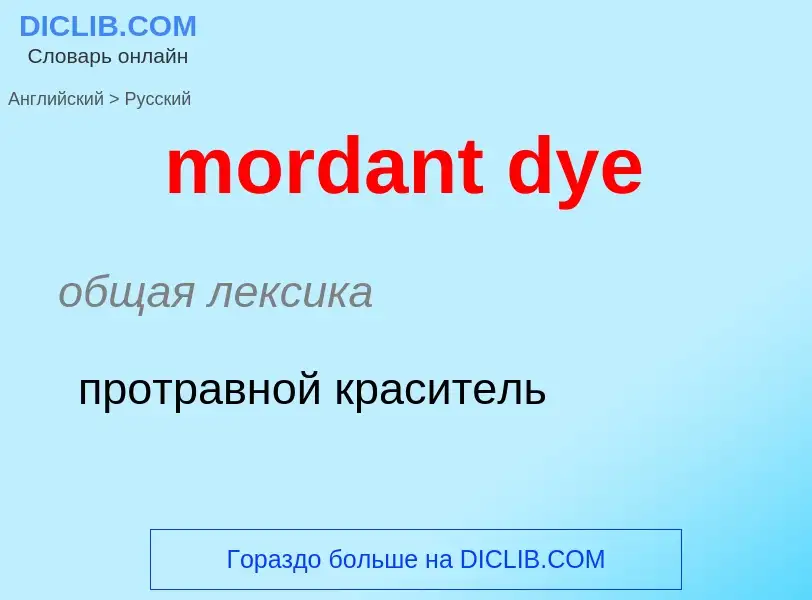Translation and analysis of words by ChatGPT artificial intelligence
On this page you can get a detailed analysis of a word or phrase, produced by the best artificial intelligence technology to date:
- how the word is used
- frequency of use
- it is used more often in oral or written speech
- word translation options
- usage examples (several phrases with translation)
- etymology
mordant dye - translation to russian
общая лексика
протравной краситель
[mɔ:dnt]
общая лексика
морильный
гистология
протрава
химия
клей
краситель адъективный
Смотрите также
прилагательное
общая лексика
колкий
язвительный
саркастический
протравной (о красителе, крашении)
травящий (при гравировании)
колкий, язвительный, саркастический
закрепляющий краску
редкое выражение
разъедающий
вызывающий разрушение или коррозию
химия
едкий
медицина
вызывающий разрушение (ткани)
существительное
[mɔ:dnt]
общая лексика
протрава (при крашении)
морилка
травящее вещество
протравка (при гравировании)
протравка (при гравировании)
протрава (при крашении)
Definition
Wikipedia
A dye is a colored substance that chemically bonds to the substrate to which it is being applied. This distinguishes dyes from pigments which do not chemically bind to the material they color. Dye is generally applied in an aqueous solution and may require a mordant to improve the fastness of the dye on the fiber.
The majority of natural dyes are derived from non-animal sources: roots, berries, bark, leaves, wood, fungi and lichens. In the 21st century, most dyes are synthetic, i.e., are man-made from petrochemicals. Some are extracted from insects and or minerals.
Synthetic dyes are produced from various chemicals. The great majority of dyes are obtained in this way because of their superior cost, optical properties (color), and resilience (fastness, mordancy). Both dyes and pigments are colored, because they absorb only some wavelengths of visible light. Dyes are usually soluble in some solvent, whereas pigments are insoluble. Some dyes can be rendered insoluble with the addition of salt to produce a lake pigment.

![Yarn drying after being dyed in the early American tradition, at [[Conner Prairie]] [[living history museum]]. Yarn drying after being dyed in the early American tradition, at [[Conner Prairie]] [[living history museum]].](https://commons.wikimedia.org/wiki/Special:FilePath/Conner-prairie-yarn-drying.jpg?width=200)
![Dyeing wool cloth, 1482: from a French translation of [[Bartolomaeus Anglicus]] Dyeing wool cloth, 1482: from a French translation of [[Bartolomaeus Anglicus]]](https://commons.wikimedia.org/wiki/Special:FilePath/Dyeing British Library Royal MS 15.E.iii, f. 269 1482.jpg?width=200)
![A [[woman]] dyeing her [[hair]]. A [[woman]] dyeing her [[hair]].](https://commons.wikimedia.org/wiki/Special:FilePath/Hårfärgning - 2007.jpg?width=200)
![The discovery of [[Congo red]] in 1883, followed by many other synthetic [[azo dye]]s, heralded the demise of mordant dyes. The discovery of [[Congo red]] in 1883, followed by many other synthetic [[azo dye]]s, heralded the demise of mordant dyes.](https://commons.wikimedia.org/wiki/Special:FilePath/Congo-red-2D-skeletal.png?width=200)

![chelating to metal cations]]. chelating to metal cations]].](https://commons.wikimedia.org/wiki/Special:FilePath/Mordant red 19.png?width=200)
